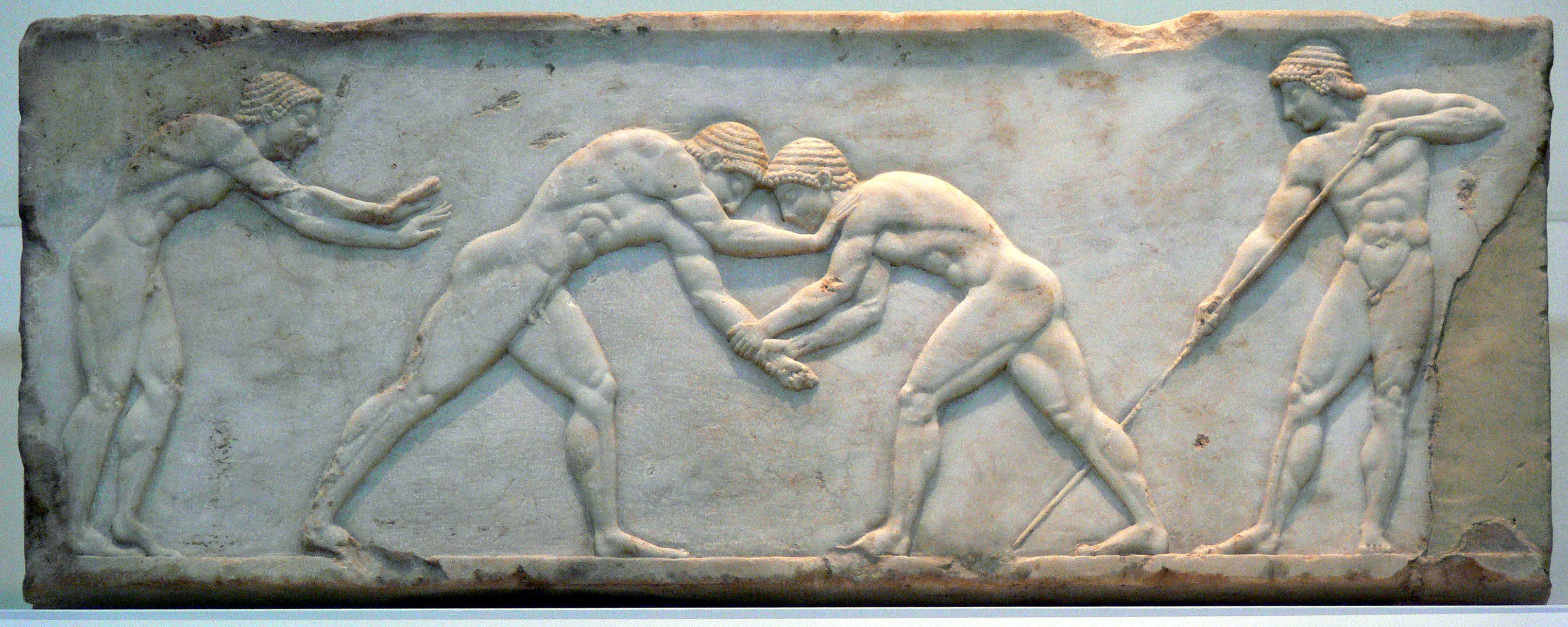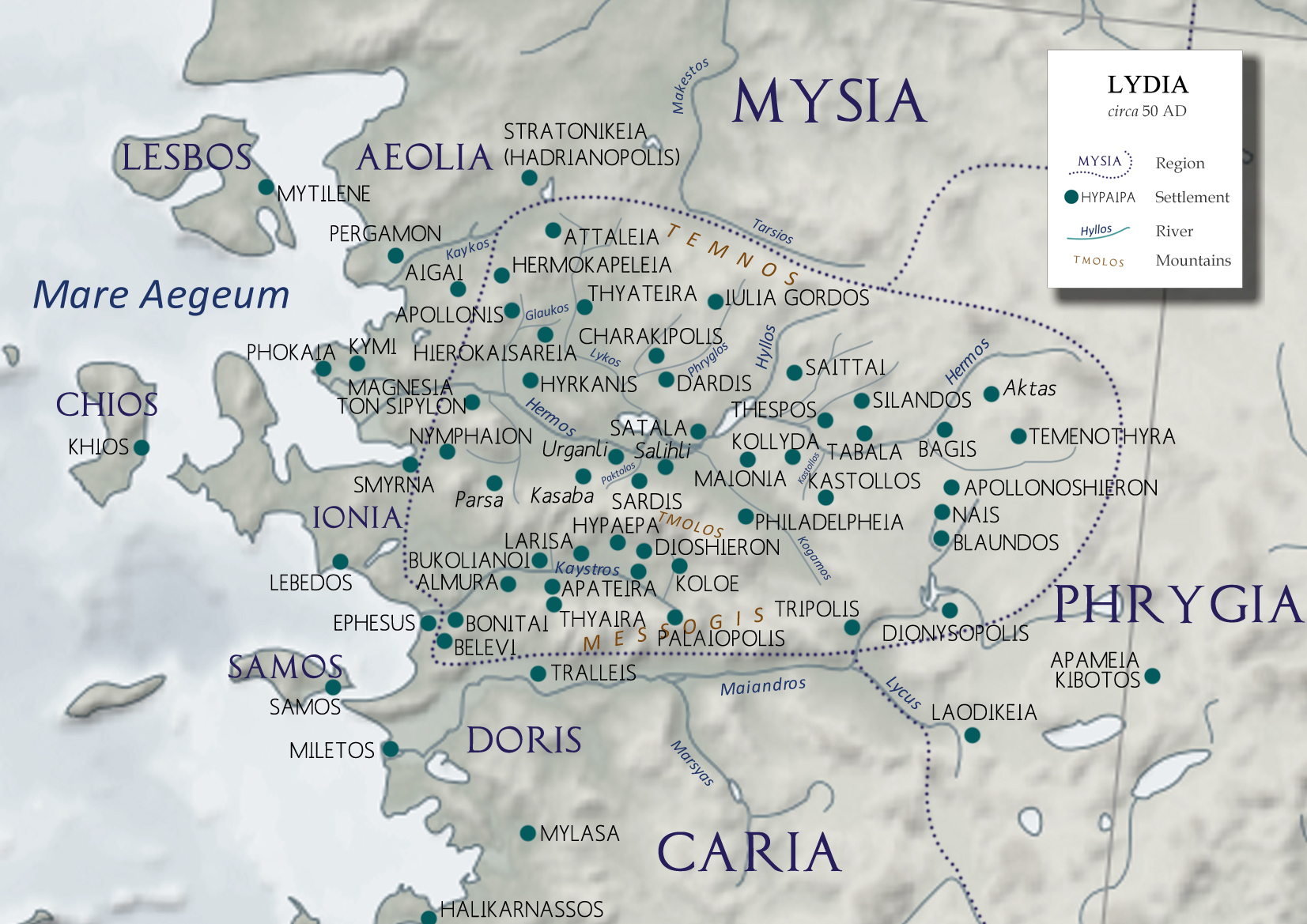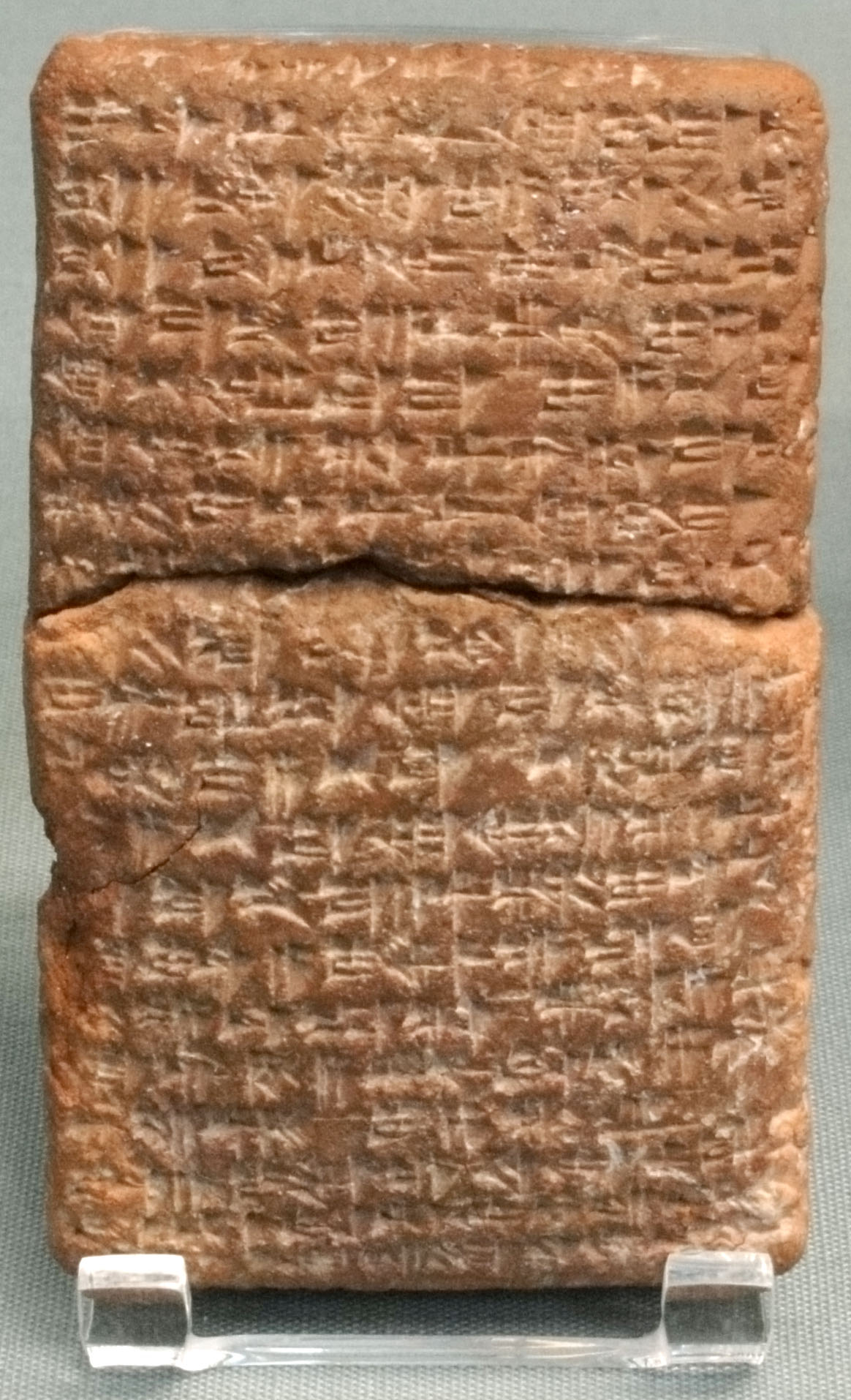|
Greek Wrestling
Greek wrestling (), also known as Ancient Greek wrestling and Pále (πάλη), was the most popular organized sport in Ancient Greece. A point was scored when one player touched the ground with his back, hip or shoulder, or conceding defeat due to a submission-hold or was forced out of the wrestling-area. Three points had to be scored to win the match. One particularly important position in this form of wrestling was one where one of the contestants was lying on his abdomen with the other on his back trying to strangle him (back mount). The athlete on the bottom would try to grasp an arm of the one on top and turn him over onto his back while the athlete on top would try to complete the choke without being rolled. Wrestling was the first competition to be added to the Olympic Games that was not a footrace. It was added in 708 B.C. (Miller, 46). The competitions were held in elimination-tournament style until one wrestler was crowned the victor. The wrestling area was one square ... [...More Info...] [...Related Items...] OR: [Wikipedia] [Google] [Baidu] |
Stater
The stater (; ) was an ancient coin used in various regions of Greece. The term is also used for similar coins, imitating Greek staters, minted elsewhere in ancient Europe. History The stater, as a Greek silver currency, first as ingots, and later as coins, circulated from the 8th century BC to AD 50. The earliest known stamped stater (having the mark of some authority in the form of a picture or words) is an electrum turtle coin, struck at Aegina that dates to about 650 BC. It is on display at the Bibliothèque Nationale in Paris. According to Robin Lane Fox, the stater as a weight unit was borrowed by the Euboean stater weighing from the Phoenician shekel, which had about the same weight as a stater () and was also one fiftieth of a mina.Lane Fox, Robin. ''Travelling Heroes: Greeks and Their Myths in the Epic Age of Homer''. P. 94. London: Allen Lane, 2008. The silver stater minted at CorinthSmith, William. ''A Dictionary of Greek and Roman Antiquitie ... [...More Info...] [...Related Items...] OR: [Wikipedia] [Google] [Baidu] |
Diogenes Laertius
Diogenes Laërtius ( ; , ; ) was a biographer of the Greek philosophers. Little is definitively known about his life, but his surviving book ''Lives and Opinions of Eminent Philosophers'' is a principal source for the history of ancient Greek philosophy. His reputation is controversial among scholars because he often repeats information from his sources without critically evaluating it. In many cases, he focuses on insignificant details of his subjects' lives while ignoring important details of their philosophical teachings and he sometimes fails to distinguish between earlier and later teachings of specific philosophical schools. However, unlike many other ancient secondary sources, Diogenes Laërtius tends to report philosophical teachings without trying to reinterpret or expand on them, and so his accounts are often closer to the primary sources. Due to the loss of so many of the primary sources on which Diogenes relied, his work has become the foremost surviving source on the ... [...More Info...] [...Related Items...] OR: [Wikipedia] [Google] [Baidu] |
Thebes, Greece
Thebes ( ; , ''Thíva'' ; , ''Thêbai'' .) is a city in Boeotia, Central Greece (administrative region), Central Greece, and is one of the oldest continuously inhabited cities in the world. It is the largest city in Boeotia and a major center for the area along with Livadeia and Tanagra. It played an important role in Greek myths, as the site of the stories of Cadmus, Oedipus, Dionysus, Heracles and others. One myth had the city founded by Agenor, which gave rise to the (now somewhat obscure) name "Agenorids" to denote Thebans. Archaeological excavations in and around Thebes have revealed a Mycenaean Greece, Mycenaean settlement and clay tablets written in the Linear B script, indicating the importance of the site in the Bronze Age. Thebes was the largest city of the ancient region of Boeotia and was the leader of the Boeotian confederacy. It was a major rival of Classical Athens, ancient Athens, and sided with the Achaemenid Empire, Persians during the Second Persian invasi ... [...More Info...] [...Related Items...] OR: [Wikipedia] [Google] [Baidu] |
Phigalia
Phigalia or Phigaleia or Phigalea ( or ΦιγαλέαSo in Polybius, '' The Histories, iv. 3.'' or Φιγάλεια or ΦιγαλίαSo in Pausanias), also known as Phialia (Φιαλία or Φιάλεια), was an ancient Greek city in the south-west corner of ancient Arcadia, in the region of ancient Parrhasia close to the frontiers of Messenia, and upon the right bank of the Neda, about halfway between the sources and the mouth of this river. It is also the present name of a nearby modern village, known up to the early 20th century as Pavlitsa (Παύλιτσα). In modern geography it is located in southeastern Elis. It is situated on an elevated rocky site, among some of the highest mountains in the Peloponnese, the most conspicuous being Mt Cotylium and Mt Elaeum; the identification of the latter is uncertain. Name The name Phigalia was more ancient than that of Phialia, but the original name had again come into use in the time of Pausanias.Pausanias, ''Description of ... [...More Info...] [...Related Items...] OR: [Wikipedia] [Google] [Baidu] |
Chilon Of Patras
Chilon of Patras () was a wrestler from Patras, Achaea, son of Chilon. He won at wrestling in the 112th and the 113th Olympic Games, four times in Isthmia, three in Nemea and two times at Pythia. He was killed in a battle, according to Pausanias either at Chaeronea or at Lamia. The statue of Chilon at Olympia was made by Lysippus. One hypothesis suggests that Lysippus' Apoxyomenos could represent Chilon and that its fate would have been the one described by Pliny the Elder in his ''Natural History'' (XXXIV, 62) : the bronze statue was moved from Olympia to Rome, and Agrippa had it erected in front of the baths. Tiberius Tiberius Julius Caesar Augustus ( ; 16 November 42 BC – 16 March AD 37) was Roman emperor from AD 14 until 37. He succeeded his stepfather Augustus, the first Roman emperor. Tiberius was born in Rome in 42 BC to Roman politician Tiberius Cl ... moved it back to its original place after popular demand., page 43. References {{DEFAULTSORT:Chilon Of Pat ... [...More Info...] [...Related Items...] OR: [Wikipedia] [Google] [Baidu] |
Heraea (Arcadia)
Heraea or Heraia () was the most important town of ancient Arcadia on the Lower Alpheius. It was situated near the frontiers of Elis, and on the high road from Arcadia to Olympia. Its territory was called the Heraeatis or Heraiatis (Ἡραιᾶτις). According to Greek mythology it was said to have been founded by Heraeus, a son of Lycaon, and to have been called originally Sologorgus. At an early period the Heraeans concluded a treaty with the Eleians for mutual protection and support for one hundred years; the original of which treaty, engraved on a bronze tablet in the old Peloponnesian dialect, was brought from Olympia, and is now in the British Museum. This treaty is placed about the 50th Olympiad, or 580 BCE, since it belongs to a time when the Eleians exercised an undisputed supremacy over the dependent districts of Pisatis and Triphylia; and the Heraeans consequently were anxious to avail themselves of their support. Heraea was, at that time, the chief village am ... [...More Info...] [...Related Items...] OR: [Wikipedia] [Google] [Baidu] |
Aegeira
Aigeira () (, or Αἴγειρα, ) is a town and a former municipality in northeastern Achaea, West Greece, Greece. Since the 2011 local government reform it has been a municipal unit of the Aigialeia municipality, with an area of 103.646 km2. The municipal unit stretches from the Gulf of Corinth, where the town of Aigeira is located, to the mountains in the south. The town of Aigeira is southeast of Aigio, northwest of Corinth and east of Patras. The archaeological site of ancient Aigeira is located approximately from the modern town. It is an important site for the Mycenaean and later periods, with particularly extensive remains from the Hellenistic period. It has been excavated since 1916 by archaeologists from the Austrian Archaeological Institute at Athens. History Prehistory (Location of the ancient site: ) Settlement at Aigeira is known from the Middle Neolithic and Final Neolithic, beginning around 5500 BCE. The first settlement was situated on the acropol ... [...More Info...] [...Related Items...] OR: [Wikipedia] [Google] [Baidu] |
Smyrna
Smyrna ( ; , or ) was an Ancient Greece, Ancient Greek city located at a strategic point on the Aegean Sea, Aegean coast of Anatolia, Turkey. Due to its advantageous port conditions, its ease of defence, and its good inland connections, Smyrna rose to prominence. Since about 1930, the city's name has been İzmir. Two sites of the ancient city are today within İzmir's boundaries. The first, probably founded by indigenous peoples, rose to prominence during the Archaic period in Greece, Archaic Period as one of the principal ancient Greek settlements in western Anatolia. The second, whose foundation is associated with Alexander the Great, reached metropolitan proportions during the period of the Roman Empire. Most of the ancient city's present-day remains date to the Roman era, the majority from after a 2nd-century AD earthquake. In practical terms, a distinction is often made between these. ''Old Smyrna'' was the initial settlement founded around the 11th century BC, first as an ... [...More Info...] [...Related Items...] OR: [Wikipedia] [Google] [Baidu] |
Cilicia
Cilicia () is a geographical region in southern Anatolia, extending inland from the northeastern coasts of the Mediterranean Sea. Cilicia has a population ranging over six million, concentrated mostly at the Cilician plain (). The region includes the provinces of Mersin, Adana, Osmaniye and Hatay. Name The name of Cilicia () was derived from (), which was the name used by the Neo-Assyrian Empire to designate the western part of what would become Cilicia. The English spelling is the same as the Latin, as it was transliterated directly from the Greek form Κιλικία. The palatalization of c occurring in Western Europe in later Vulgar Latin () accounts for its modern pronunciation in English. Geography Cilicia extends along the Mediterranean coast east from Pamphylia to the Nur Mountains, which separate it from Syria. North and east of Cilicia stand the rugged Taurus Mountains, which separate it from the high central plateau of Anatolia, and which are pierced by a ... [...More Info...] [...Related Items...] OR: [Wikipedia] [Google] [Baidu] |
Stratonicea (Caria)
Stratonicea ( Hittite: 𒀜𒊑𒅀 ''Atriya'', ; or per Stephanus of Byzantium: Στρατονίκεια) – also transliterated as Stratonikeia, Stratoniceia, Stratoniki, and Stratonike and Stratonice; a successor settlement to Chrysaoris; and for a time named Hadrianopolis – was one of the most important towns in the interior of ancient Caria, Anatolia, situated on the east-southeast of Mylasa, and on the south of the river Marsyas; its site is now located at the present village of Eskihisar, Muğla Province, Turkey. It is situated at a distance of from the intercity road D.330 that connects the district center of Yatağan with Bodrum and Milas, shortly before Yatağan power station if one has taken departure from the latter towns. Foundation and Seleucid era Some scholars identified the city of Atriya from the Hittite documents as Stratonicea. Atriya played an important role during the conflict between the Mycenean Greek colonists (Ahhiyawa) and native Anatolians. D ... [...More Info...] [...Related Items...] OR: [Wikipedia] [Google] [Baidu] |
Magnesia On The Meander
Magnesia may refer to: Chemistry and geology *Magnesium oxide **Periclase or magnesia, a natural mineral of magnesium oxide * Magnesian limestone (other) *Magnesium *Milk of magnesia, a suspension of magnesium hydroxide Geography * Magnesia (hypothetical city), a future colony of Knossos, imagined in Plato's ''Laws'' *Magnesia (regional unit), the southeastern area of Thessaly in central Greece *Ancient Magnesia, a historical region of Greece with borders differing from the modern regional unit *Magnesia ad Sipylum, a city of Lydia, now Manisa in Turkey **Battle of Magnesia The Battle of Magnesia took place in either December 190 or January 189 BC. It was fought as part of the Roman–Seleucid War, pitting forces of the Roman Republic led by the Roman consul, consul Lucius Cornelius Scipio Asiaticus and the allied ..., 190 BC, the concluding battle of the Roman–Seleucid War * Magnesia on the Maeander, an ancient Greek city in Anatolia * Magnesia Prefecture, a ... [...More Info...] [...Related Items...] OR: [Wikipedia] [Google] [Baidu] |
Alexandria
Alexandria ( ; ) is the List of cities and towns in Egypt#Largest cities, second largest city in Egypt and the List of coastal settlements of the Mediterranean Sea, largest city on the Mediterranean coast. It lies at the western edge of the Nile Delta, Nile River delta. Founded in 331 BC by Alexander the Great, Alexandria grew rapidly and became a major centre of Hellenic civilisation, eventually replacing Memphis, Egypt, Memphis, in present-day Greater Cairo, as Egypt's capital. Called the "Bride of the Mediterranean" and "Pearl of the Mediterranean Coast" internationally, Alexandria is a popular tourist destination and an important industrial centre due to its natural gas and petroleum, oil pipeline transport, pipelines from Suez. The city extends about along the northern coast of Egypt and is the largest city on the Mediterranean, the List of cities and towns in Egypt#Largest cities, second-largest in Egypt (after Cairo), the List of largest cities in the Arab world, fourth- ... [...More Info...] [...Related Items...] OR: [Wikipedia] [Google] [Baidu] |





